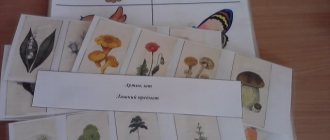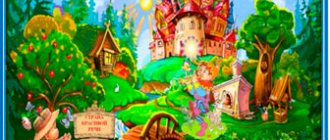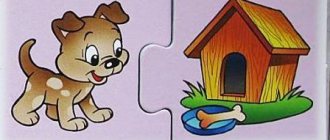Action pictures for children
Pictures depicting actions will help teachers and parents organize their children’s education correctly and at the same time in an interesting way.
Colorful drawings stimulate the child’s memory and imagination. They will invariably attract and concentrate children's attention. They will direct the learning process in the right direction.
The purpose of such activities may be:
- identifying the level of the child’s vocabulary and increasing it;
- development of coherent speech;
- constructing correct simple/complex sentences;
- teach your child to select and correctly use different parts of speech;
- compose questions yourself and specifically answer those asked by your interlocutor;
- stimulation of memory, fantasy;
- development of logical thinking;
- training of observation, taking out;
- activation of imagination;
- acquiring new social experience.
Not only pictures depicting actions, but also illustrations of objects (furniture, dishes, vegetables and fruits), plot drawings are indispensable assistants in the learning process of preschoolers.
Categories by age
Action pictures like these require adults to adapt questions to the age of the children.
- 1-2 years - encourage the child to look at illustrations, find, name, show objects;
- 2-4 years – learn to compose sentences using different parts of speech. Describe the entire plot in short answers;
- 4-5 years – detailed description of individual objects, character behavior, processes. Repeating images created by an adult, as well as inventing your own continuation of the plot;
- 5-6 years - drawing up a plan for future children's stories.
Classes are conducted with subgroups of children or individually. The same image can be used first for learning purposes, and then (next lesson) to reinforce the material.
Game "Who needs it?"
Target
.
To consolidate children’s ideas about objects and their use in work processes. Introduce professions. Progress of the game:
The teacher shows the children various objects, asks them to name them and tell them when they are used and for what purpose. For example: this is a ladle, the cook needs it to stir porridge, pour soup and compote, etc. When playing a game with children of senior preschool age, the teacher selects different pictures depicting objects. For example: pliers, hammer, vacuum cleaner, coffee grinder, steering wheel, computer, microphone, drawing board, centimeter, microscope, telescope, jackhammer, etc. Children name the profession of the person who uses the depicted object in his work.
Game "Choose a job"
Target
.
To give children a basic understanding of the professions of people whose work was not in the sphere of their observations. Arouse interest in the work of people of any profession. Progress of the game:
The teacher, together with the children, gets up in a round dance and invites them to walk in a circle, saying: Let us grow up together and choose a job. We will become astronauts and fly rockets. (Children imitate the sound of an engine and the flight of a rocket, following the teacher’s instructions.) We will become captains, we will lead ships. (Children show how the captain looks through binoculars.) Let's go to helicopter pilots, let's fly helicopters. (Children run and make circular movements with their arms above their heads.) The game can be continued with older children; they already independently imitate the appropriate actions. And we will become pilots, we will fly airplanes. The first two lines are repeated at the beginning of each verse, the children walk in a circle to these words. We will go to combine harvesters and drive combine harvesters. We'll go to the fire department and start putting out the fire.
The game “Why (why, why) do you need to do this?”
Target
.
To form in children an idea of the need for labor, to expand knowledge about labor processes. Progress of the game:
The teacher shows the children a picture depicting an object that characterizes a particular action. Children must name this action. - Why do you need a plant? (Water can.) - Why do you need to feed? (Bird.) - What needs to be washed? (Plate.) - What needs to be cleaned? (Carpet.) - What needs to be washed? (Dress.) - What needs to be ironed? (Shirt.) - What do you need to bake? (Pies.) - What needs to be changed? (Bed linen.) - Who needs to be bathed? (Child.) Children of older preschool age are asked more difficult questions. - Why sow fields? (Grain.) - Why plant? (Potatoes.) - Why spray? (Apple tree.) - Why buy bread (milk, sausages, fruit) in the store? — Why repair a broken toy? — Why do weekly cleaning of the apartment? - Why take care of your body?
DIDACTICAL GAMES ON LABOR EDUCATION FOR CHILDREN AGED 5-7 YEARS OLD
Game "Guess what I'm doing?"
Target
.
Expand children's understanding of work activities. Develop attention. Progress of the game:
The teacher and children join hands and stand in a circle. A child comes to the center of the circle. Everyone goes in a circle and says: We don’t know what you’re doing, Let’s take a look and guess. The child imitates labor actions not only with movements, but also (if possible) with sounds. For example, he cleans the floor with a vacuum cleaner, hammers a nail, saws, drives a car, does laundry, carries a bucket of water, wipes a mirror, chops wood, grates, turns something in a meat grinder, etc. Children guess the actions.
Game “What first, what then?”
Target.
Clarify children's knowledge about the rules of replanting indoor plants.
Progress of the game:
The teacher shows the children pictures depicting the stages of replanting indoor plants and asks them to arrange them in the order in which the actions are performed. • A pot is overturned and the plant is removed from it. • Washing the potty. • Laying pebbles at the bottom of the pot. • Pour sand into the pot (height 1 cm). • Pour some soil into the pot on top of the sand. • Shaking off old soil from the roots of the plant with a stick. • Cutting off rotten roots. • Planting the plant in a pot so that the transition point between the stem and the root is on the surface, and covering it with soil. • Compaction of the earth. • Installing a pot with a plant on a pallet. • Watering the plant at the root.
Game "Name the profession."
Target
.
Teach children to correctly name people's professions by the types of cars they drive. Progress of the game:
The teacher names cars, vehicles and other technical means, and the children name the professions of the people who drive them. Tractor - tractor driver. The car is a driver. Excavator - excavator operator. Combine - combine harvester. Crane - crane operator. Train driver. The ship is the captain. Airplane - pilot (pilot). Spaceship - astronaut. Fire truck - fireman. Bulldozer - bulldozer driver. Racing car - racer (pilot). Etc.
Game "Guess the profession."
Target
.
Expand children's ideas about professions. Progress of the game:
The teacher shows the children an object picture. Children name the profession of the person in whose work this object is used or is the result of his work. Rabbit is a rabbit breeder. Calf - calf. Sheep is a sheep farmer. Deer - reindeer herder. Grapes - winegrower. Tea - tea grower. Bread - grain grower. Garden - gardener. Flowers - florist. Bee is a beekeeper. Field - field farmer. Wrench - locksmith. Bucket and mop—cleaning lady. Ticket - conductor. Cashier - cashier. Planer - carpenter. Paint and brush - painter. Trowel - plasterer. Kuhlman is an engineer. Hammer and anvil - blacksmith. Fire extinguisher - fireman. Syringe is a nurse. Electric saw - lumberjack. Fishing net - fisherman. Dental chair - dentist. Milking machine - milkmaid..
The game “Who can’t do without them?”
Target.
To consolidate children's knowledge about materials, tools and equipment needed by people of different professions.
Progress of the game:
The teacher names the item, and the children name the profession of the person who needs it. For example: a syringe, a control panel, scissors, flour, a garden sprayer, a telephone, a milking machine, a stretcher, a plane, a wheelbarrow, a police baton, a drill, an electrical cable, a nail, a roll of wire, a cash register, a postman's bag, a roll of wallpaper, a cash register, a pencil, brush, tray, bell.




